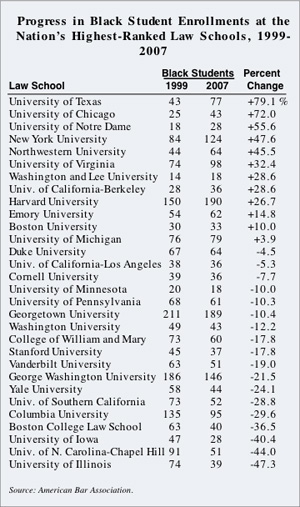| Declining Black Enrollments at Many of the Nation’s Highest-Ranked Law Schools Over the past eight years black enrollments have declined at a majority of the top-ranked law schools. At nine high-ranking law schools black enrollments are down by 19 percent or more. Three prestigious law schools in the nation show declines of more than 40 percent.
But during this same period only 12 of the nation’s 30 highest-ranked law schools have shown an increase in black enrollments. Eighteen of the 30 leading law schools saw a decline in black enrollments. At the University of Texas, black enrollments increased from 43 students in 1999 to 77 students in 2007. Remember that due to the 1996 Hopwood ruling by the Fifth Circuit Court of Appeals, the law school at the University of Texas was prohibited from using race in admissions decisions. This produced a major headwind in black enrollments at the law school. The 2003 ruling by the U.S. Supreme Court in the Grutter case overturned the Hopwood ruling. This enabled the University of Texas School of Law to once again consider race in its admissions decisions. Over the past eight years, black enrollments at the law school have increased by nearly 80 percent. The prestigious law school at the University of Chicago also saw a major increase in black enrollments during the period. There were 43 black students at the law school in 2007, an increase of 72 percent from 1999. This improvement has been mirrored by large increases in black enrollments in the undergraduate college of the University of Chicago. Three other high-ranking law schools showed increases in black enrollments greater than 40 percent in the 1999 to 2007 period. They were the University of Notre Dame, Northwestern University, and New York University. In past years, the law school at New York University had been criticized for a lukewarm commitment to affirmative action. However, it now appears that the school has made a solid and successful effort to increase black enrollments. Dean Richard Revesz of the New York University law school told JBHE that “a diverse student body has been and continues to be a priority.” He said that the school has instituted a number of strategies to increase black enrollments. One program offers scholarships to students who are the first in their families to enroll in a professional school and who come from backgrounds with a severe economic disadvantage. The law school conducts extensive recruiting activities at historically black colleges and universities and other institutions with large percentages of African-Ameri-can students. Also, the black law school student association at NYU has been active in recruiting students through telephone campaigns and through visits to their alma maters. Harvard, the University of Virginia, Boalt Hall at the University of California at Berkeley, and Washington and Lee University all posted gains in black enrollments of 20 percent or more. Emory, Boston University, and the University of Michigan were the only other schools among the nation’s 30 highest-ranked law schools to post gains in black enrollments during the period. Law Schools With Declines in Black Enrollments At 18 of the nation’s 30 highest-ranked law schools, black student enrollments declined over the eight-year period from 1999 to 2007. At nine of the 30 top law schools, black enrollments dropped by 19 percent or more. Three large schools saw black enrollments decline by more than 40 percent. The largest decline was at the law school at the University of Illinois. In 1999 there were 74 black students enrolled at the law school at the university. By 2007 the number of black students at the law school dropped to 39, a decrease of 47.3 percent from eight years ago. The law schools at the University of North Carolina at Chapel Hill and the University of Iowa also saw decreases in black enrollments of more than 40 percent. During this eight-year period, intense pressures were placed on state-operated universities and graduate schools to scale back on affirmative action admissions programs. Conservative litigation groups threatened suits against state-operated universities if they continued to aggressively pursue race-sensitive admissions. The large decrease in black enrollments at the University of Southern California law school, a private institution, may be the direct result of the Proposition 209 ban on race-sensitive admissions at state-operated colleges and universities. The pool of black undergraduates at the eight undergraduate campuses of the University of California was drastically reduced during this period. Therefore, the number of black students in California who were adequately prepared to gain admission to the law school at USC was undoubtedly far lower than had been the case in previous years. Among the top-ranked Ivy League law schools, only Harvard showed an increase in black enrollments. At Yale, Columbia, and the University of Pennsylvania, black en-rollments were down by at least 10 percent. JBHE asked several leading scholars at these three Ivy League law schools to comment on the drop in black enrollments at these schools. We did not receive any replies. Other law schools that showed major declines in black enrollments include Boston College, Stanford, and George Washington University. Tracking black progress at these elite educational institutions is an important barometer for gauging how blacks are faring in reaching the top echelons of the legal profession. The leading law firms in this country recruit a large majority of their associates at the nation’s leading law schools. Many of these highly selective firms now offer starting salaries to inexperienced first-year associates of up to $150,000. Also, the nation’s top law schools typically produce the law clerks for the nation’s Supreme Court justices and other federal judgeships. |
|




 Nationwide in 1999 there were 9,271 black students enrolled at the nation’s approximately 180 accredited law schools. Eight years later in 2007 there were 9,529 black students enrolled in American law schools, an increase of 2.8 percent.
Nationwide in 1999 there were 9,271 black students enrolled at the nation’s approximately 180 accredited law schools. Eight years later in 2007 there were 9,529 black students enrolled in American law schools, an increase of 2.8 percent.